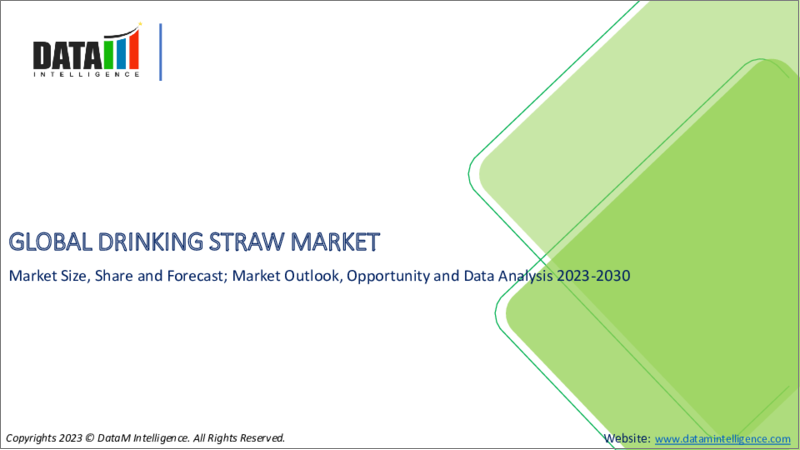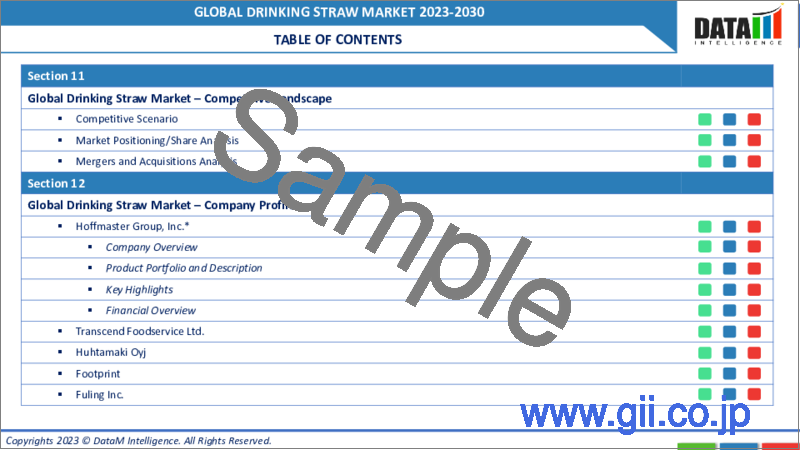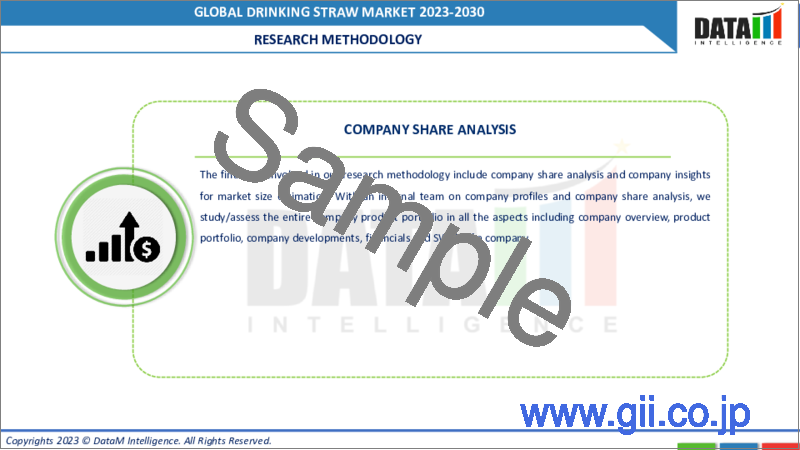|
|
市場調査レポート
商品コード
1285065
飲料用ストローの世界市場-2023-2030Global Drinking Straw Market - 2023-2030 |
||||||
カスタマイズ可能
適宜更新あり
|
|||||||
| 飲料用ストローの世界市場-2023-2030 |
|
出版日: 2023年06月05日
発行: DataM Intelligence
ページ情報: 英文 112 Pages
納期: 即日から翌営業日
|
- 全表示
- 概要
- 目次
市場の概要
世界の飲料用ストロー市場は、2022年に258億4,500万米ドルに達し、2030年には最大1,362億8,200万米ドルに達することで有利な成長を遂げると予測されます。同市場は予測期間(2023-2030年)に23.1%のCAGRで成長する見通しです。
世界の飲料用ストロー市場は、今後数年間は堅調な成長を遂げる見込みです。使い捨てのプラスチック製ストローが環境に与える影響に対する消費者の意識の高まりが、大きな推進力となっています。個人や政府がプラスチック廃棄物の削減に努める中、持続可能な代替品への需要が高まっています。このような消費者行動の変化が、紙、竹、ステンレススチール、生分解性プラスチックなどの環境に優しい素材のストロー市場への採用を後押ししています。いくつかの国では、使い捨てプラスチックに対する厳しい規制や禁止令があり、市場の成長を加速しています。世界中の政府がプラスチック製ストローの使用を制限する施策を実施し、持続可能な代替品に有利な環境を作り出しています。このような規制環境が、環境に優しいストローの市場開拓と生産への投資をメーカーに促し、市場の拡大をさらに後押ししています。
市場力学
各国における使い捨てプラスチックの厳しい規制と禁止が市場成長を促進
各国における厳しい規制と使い捨てプラスチックの禁止は、世界の飲料用ストロー市場の主要な促進要因となっています。これらの規制措置は、代替素材や持続可能なソリューションの導入に有利な環境を作り出し、環境に優しいストローの市場需要増加につながります。政府や規制機関が、プラスチック製ストローを含む使い捨てプラスチックの環境への影響に対処するため、より厳しい政策を実施するにつれ、企業や消費者はより持続可能な代替品を見つけなければならないという切迫感を持つようになりました。こうした規制には、特定の種類のプラスチック製ストローの使用制限や全面的な禁止が含まれることが多く、市場は環境に配慮した選択肢を求めるようになります。
持続可能な製品とパッケージングに対する消費者の嗜好の変化が市場の成長を促す
持続可能な製品やパッケージに対する消費者の嗜好の変化は、世界のストロー市場を牽引する極めて重要な役割を担っています。消費者は自分の選択が環境に与える影響をより意識するようになり、環境に優しいストローなど、持続可能な代替品を積極的に求めるようになりました。このような消費者の嗜好の変化は、市場力学に大きな影響を及ぼしています。メーカーは、生分解性、利便性、または再利用可能なストローを積極的に開発・生産し、消費者に持続可能な選択肢を提供しています。
例えば、9月9日に2020年、Lassonde社は刺激的な発表を行い、KijuとSimple Drop Natural Spring Water製品のすべての200mlシングルサーブボックスにおいて、プラスチックストローを曲げられるペーパーストローに置き換えることを決めたと述べました。この積極的な取り組みは、消費者に100%リサイクル可能なパッケージを提供することを目的としており、Lassondeの持続可能な実践への取り組みと一致しています。
COVID-19の影響分析
COVID-19の流行は、世界の飲料用ストロー市場に大きな影響を及ぼしました。外食産業の閉鎖や制限により、飲料用ストローの市場需要は減少しました。サプライチェーンと製造能力の混乱は、市場力学にさらに影響を与えました。しかし、衛生面への関心の高まりにより、一部の市場では個包装や使い捨てのストローの販売機会が生まれました。外食産業が回復するにつれ、持続可能で衛生的なストローソリューションへの継続的な需要によって、市場は適応し回復すると予想されます。
人工知能の影響分析
人工知能(AI)は、世界の飲料用ストロー市場に革命をもたらしています。AI駆動のシステムは製造プロセスを最適化し、効率と製品品質を向上させます。AIアルゴリズムは消費者データを分析し、企業が嗜好を理解してマーケティング戦略を調整し、市場成長を促進することを可能にします。AIを搭載したチャットボットは、顧客サービスを強化し、パーソナライズされた提案を提供し、消費者体験を向上させます。また、AIは持続可能性への取り組みを推進し、サプライチェーンを最適化し、市場の将来のために環境に優しい素材を開発します。
目次
第1章 調査手法とスコープ
- 調査手法
- 調査目的および調査範囲
第2章 定義と概要
第3章 エグゼクティブサマリー
- タイプ別スニペット
- 形状別スニペット
- 用途別スニペット
- 地域別スニペット
第4章 市場力学
- 影響要因
- 促進要因
- 使い捨てプラスチックストローが環境に与える影響に対する意識の高まりが、市場の成長を促進する
- 抑制要因
- 生分解性物質の回収と処理のための適切な廃棄物管理インフラがないことが、市場成長の妨げになります
- 機会
- 世界のフードサービス産業の拡大が市場成長の機会を生み出す
- 影響分析
- 促進要因
第5章 産業分析
- ポーターのファイブフォース分析
- サプライチェーン分析
- 価格分析
- 法規制の分析
第6章 COVID-19の分析
- COVID-19の分析
- COVID-19の前のシナリオ
- COVID-19期間中のシナリオ
- COVID-19後のシナリオと今後のシナリオ
- COVID-19の中での価格・ダイナミクス
- 需給スペクトル
- パンデミック時の市場に関連する政府の取り組み
- メーカーの戦略的な取り組み
- サマリー
第7章 タイプ別
- プラスチック製
- 紙製ストロー
第8章 形状別
- ストレートストロー
- U字型ストロー
- テレスコピックストロー
第9章 用途別
- 外食産業
- 業務
- 家庭
第10章 地域別
- 北米
- 米国
- カナダ
- メキシコ
- 欧州
- ドイツ
- 英国
- フランス
- イタリア
- スペイン
- その他欧州
- 南米
- ブラジル
- アルゼンチン
- その他南米地域
- アジア太平洋地域
- 中国
- インド
- 日本
- オーストラリア
- その他アジア太平洋地域
- 中東・アフリカ地域
第11章 競合情勢
- 競合シナリオ
- 市況/シェア分析
- M&A(合併・買収)分析
第12章 企業プロファイル
- Hoffmaster Group Inc
- 会社概要
- 製品ポートフォリオと説明
- 財務概要
- 主な発展状況
- Huhtamaki
- Pactiv Evergreen
- Southeastern Liquid Analyzers, Inc
- StoneStraw Limited
- Paperstraw Group
- B&B Straw Pack Co., Ltd
- ACE, Absolute Custom Extrusions, Inc.
- R&M Plastic Products Ltd
- Tawfikiya Plastic Manufacturing S.A.E
第13章 付録
Market Overview
The global drinking straw market reached US$ 25,845 million in 2022 and is projected to witness lucrative growth by reaching up to US$ 136,282 million by 2030. The market is growing at a CAGR of 23.1% during the forecast period (2023-2030).
The global drinking straw market is poised for robust growth in the coming years. The increasing awareness among consumers about the environmental impact of single-use plastic straws is a major driving force. As individuals and governments strive to reduce plastic waste, there is a growing demand for sustainable alternatives. This shift in consumer behavior is propelling the adoption of eco-friendly materials such as paper, bamboo, stainless steel, and biodegradable plastics in the drinking straw market. The stringent regulations and bans on single-use plastics in several countries are accelerating the market's growth. Governments worldwide are implementing measures to restrict the use of plastic straws, creating a favorable environment for sustainable alternatives. This regulatory environment is prompting manufacturers to invest in the development and production of eco-friendly straw options, further boosting the market's expansion.
Market Dynamics
Stringent Regulations and Bans on Single-Use Plastics in Various Countries Drive the Market Growth
Stringent regulations and bans on single-use plastics in various countries are key drivers for the global drinking straw market. These regulatory measures create a favorable environment for the adoption of alternative materials and sustainable solutions, leading to increased market demand for eco-friendly straws. As governments and regulatory bodies implement stricter policies to address the environmental impact of single-use plastics, including plastic straws, it creates a sense of urgency for businesses and consumers to find more sustainable alternatives. These regulations often include restrictions or outright bans on the use of certain types of plastic straws, pushing the market towards eco-friendly options.
Shifting Consumer Preferences Toward Sustainable Products and Packaging Drive Market Growth
Shifting consumer preferences towards sustainable products and packaging is playing a pivotal role in driving the global drinking straw market. As consumers become more conscious of the environmental impact of their choices, they are actively seeking sustainable alternatives, including eco-friendly drinking straws. This shift in consumer preferences is significantly influencing the dynamics of the market. Manufacturers are actively developing and producing straws that are biodegradable, convenient, or reusable, providing consumers with sustainable choices.
For instance, on September 9. 2020, Lassonde made an exciting announcement, stating their decision to replace plastic straws with bendable paper straws in all 200-ml single-serve boxes of Kiju and Simple Drop Natural Spring Water products. This proactive initiative is geared towards offering consumers 100% recyclable packaging, aligning with Lassonde's commitment to sustainable practices.
COVID-19 Impact Analysis
The COVID-19 pandemic has had a significant impact on the global drinking straw market. Market demand for drinking straws experienced a decline due to the closures and restrictions imposed on the food service industry. Disruptions in the supply chain and manufacturing capabilities further affected the market dynamics. However, the increased focus on hygiene and sanitation created opportunities for individually wrapped or disposable straws in certain segments of the market. As the food service industry recovers, the market is expected to adapt and rebound, driven by the ongoing demand for sustainable and hygienic straw solutions.
Artificial Intelligence Impact Analysis
Artificial intelligence (AI) is revolutionizing the global drinking straw market. AI-driven systems optimize manufacturing processes, improving efficiency and product quality. AI algorithms analyze consumer data, enabling businesses to understand preferences and tailor marketing strategies to drive market growth. AI-powered chatbots enhance customer service, providing personalized recommendations and improving the consumer experience. AI also drives sustainability efforts, optimizing supply chains and developing eco-friendly materials for the market's future.
Segment Analysis
The global drinking straw market is segmented based on type, shape, application, and region.
Increased Use of Drinking Straws in the Expanding Food Industry
The food service segment held the largest share of the global drinking straw market in 2022. The food service industry encompasses a wide range of establishments such as restaurants, cafes, fast-food chains, and bars that rely heavily on the use of drinking straws to serve beverages. As economies develop and lifestyles are becoming busier, the demand for dining out, takeaway, and delivery services increase. These trends are driving the consumption of beverages that require straws, further fueling the dominance of growth within the food service segment. Manufacturers are actively developing and producing straws that are biodegradable, convenient, or reusable, providing consumers with sustainable choices.
For instance, on January 1, 2020, Yes Straws, a Ukrainian startup, introduced a breakthrough in sustainable solutions with the launch of their biodegradable single-use drinking straws. These innovative straws are crafted from cane stems, offering a renewable and eco-friendly alternative to traditional plastic straws.
Geographical Analysis
The Presence of a Strong and Well-Established Market for Food Service and Beverage Industries in North America
North America dominated the global drinking straw market in 2022. The region has a strong and well-established market for food service and beverage industries, which is driving the dominance of drinking straws. North American consumers have a culture of convenience and on-the-go consumption, leading to higher usage of straws. There is a growing awareness of environmental sustainability, prompting the adoption of eco-friendly alternatives like paper straws. North America has a robust manufacturing and distribution infrastructure, ensuring a steady supply of drinking straws to meet market demands.
Competitive Landscape
The major global drinking straw market players include Hoffmaster Group Inc, Huhtamaki, Pactiv Evergreen, Southeastern Liquid Analyzers, Inc, StoneStraw Limited, Paperstraw Group, B&B Straw Pack Co., Ltd, ACE, Absolute Custom Extrusions, Inc., R&M Plastic Products Ltd, and Tawfikiya Plastic Manufacturing S.A.E.
Why Purchase the Report?
- To visualize the global drinking straw market segmentation based on type, shape, application, and region, as well as understand key commercial assets and players.
- Identify commercial opportunities by analyzing trends and co-development.
- Excel data sheet with numerous data points of drinking straw market-level with all segments.
- PDF report consists of a comprehensive analysis after exhaustive qualitative interviews and an in-depth study.
- Product mapping available as Excel consisting of key products of all the major players.
The global drinking straw market report would provide approximately 61 tables, 51 figures, and 112 Pages.
Target Audience 2023
- Manufacturers/ Buyers
- Industry Investors/Investment Bankers
- Research Professionals
- Emerging Companies
Table of Contents
1. Methodology and Scope
- 1.1. Research Methodology
- 1.2. Research Objective and Scope of the Report
2. Definition and Overview
3. Executive Summary
- 3.1. Snippet by Type
- 3.2. Snippet by Shape
- 3.3. Snippet by Application
- 3.4. Snippet by Region
4. Dynamics
- 4.1. Impacting Factors
- 4.1.1. Drivers
- 4.1.1.1. Increasing awareness about the environmental impact of single-use plastic straws drives the market growth
- 4.1.2. Restraints
- 4.1.2.1. The lack of proper waste management infrastructure for collecting and processing biodegradable hamper the market growth
- 4.1.3. Opportunity
- 4.1.3.1. The expansion of the global foodservice industry creates opportunities for market growth
- 4.1.4. Impact Analysis
- 4.1.1. Drivers
5. Industry Analysis
- 5.1. Porters Five Force Analysis
- 5.2. Supply Chain Analysis
- 5.3. Pricing Analysis
- 5.4. Regulatory Analysis
6. COVID-19 Analysis
- 6.1. Analysis of COVID-19
- 6.1.1. Scenario Before COVID-19
- 6.1.2. Scenario During COVID-19
- 6.1.3. Post COVID-19 & Future Scenario
- 6.2. Pricing Dynamics Amid COVID-19
- 6.3. Demand-Supply Spectrum
- 6.4. Government Initiatives Related to the Market During Pandemic
- 6.5. Manufacturers Strategic Initiatives
- 6.6. Conclusion
7. By Type
- 7.1. Introduction
- 7.1.1. Market Size Analysis and Y-o-Y Growth Analysis (%), By Type
- 7.1.2. Market Attractiveness Index, By Type
- 7.2. Plastic Drinking Straw*
- 7.2.1. Introduction
- 7.2.2. Market Size Analysis and Y-o-Y Growth Analysis (%)
- 7.3. Paper Drinking Straw
8. By Shape
- 8.1. Introduction
- 8.1.1. Market Size Analysis and Y-o-Y Growth Analysis (%), By Shape
- 8.1.2. Market Attractiveness Index, By Shape
- 8.2. Straight Drinking Straws*
- 8.2.1. Introduction
- 8.2.2. Market Size Analysis and Y-o-Y Growth Analysis (%)
- 8.3. U-Shape Drinking Straws
- 8.4. Telescopic Drinking Straws
9. By Application
- 9.1. Introduction
- 9.1.1. Market Size Analysis and Y-o-Y Growth Analysis (%), By Application
- 9.1.2. Market Attractiveness Index, By Application
- 9.2. Foodservice*
- 9.2.1. Introduction
- 9.2.2. Market Size Analysis and Y-o-Y Growth Analysis (%)
- 9.3. Institutional
- 9.4. Household
10. By Region
- 10.1. Introduction
- 10.1.1. Market Size Analysis and Y-o-Y Growth Analysis (%), By Region
- 10.1.2. Market Attractiveness Index, By Region
- 10.2. North America
- 10.2.1. Introduction
- 10.2.2. Key Region-Specific Dynamics
- 10.2.3. Market Size Analysis and Y-o-Y Growth Analysis (%), By Type
- 10.2.4. Market Size Analysis and Y-o-Y Growth Analysis (%), By Shape
- 10.2.5. Market Size Analysis and Y-o-Y Growth Analysis (%), By Application
- 10.2.6. Market Size Analysis and Y-o-Y Growth Analysis (%), By Country
- 10.2.6.1. The U.S.
- 10.2.6.2. Canada
- 10.2.6.3. Mexico
- 10.3. Europe
- 10.3.1. Introduction
- 10.3.2. Key Region-Specific Dynamics
- 10.3.3. Market Size Analysis and Y-o-Y Growth Analysis (%), By Type
- 10.3.4. Market Size Analysis and Y-o-Y Growth Analysis (%), By Shape
- 10.3.5. Market Size Analysis and Y-o-Y Growth Analysis (%), By Application
- 10.3.6. Market Size Analysis and Y-o-Y Growth Analysis (%), By Country
- 10.3.6.1. Germany
- 10.3.6.2. The U.K.
- 10.3.6.3. France
- 10.3.6.4. Italy
- 10.3.6.5. Spain
- 10.3.6.6. Rest of Europe
- 10.4. South America
- 10.4.1. Introduction
- 10.4.2. Key Region-Specific Dynamics
- 10.4.3. Market Size Analysis and Y-o-Y Growth Analysis (%), By Type
- 10.4.4. Market Size Analysis and Y-o-Y Growth Analysis (%), By Shape
- 10.4.5. Market Size Analysis and Y-o-Y Growth Analysis (%), By Application
- 10.4.6. Market Size Analysis and Y-o-Y Growth Analysis (%), By Country
- 10.4.6.1. Brazil
- 10.4.6.2. Argentina
- 10.4.6.3. Rest of South America
- 10.5. Asia-Pacific
- 10.5.1. Introduction
- 10.5.2. Key Region-Specific Dynamics
- 10.5.3. Market Size Analysis and Y-o-Y Growth Analysis (%), By Type
- 10.5.4. Market Size Analysis and Y-o-Y Growth Analysis (%), By Shape
- 10.5.5. Market Size Analysis and Y-o-Y Growth Analysis (%), By Application
- 10.5.6. Market Size Analysis and Y-o-Y Growth Analysis (%), By Country
- 10.5.6.1. China
- 10.5.6.2. India
- 10.5.6.3. Japan
- 10.5.6.4. Australia
- 10.5.6.5. Rest of Asia-Pacific
- 10.6. Middle East and Africa
- 10.6.1. Introduction
- 10.6.2. Key Region-Specific Dynamics
- 10.6.3. Market Size Analysis and Y-o-Y Growth Analysis (%), By Type
- 10.6.4. Market Size Analysis and Y-o-Y Growth Analysis (%), By Shape
- 10.6.5. Market Size Analysis and Y-o-Y Growth Analysis (%), By Application
11. Competitive Landscape
- 11.1. Competitive Scenario
- 11.2. Market Positioning/Share Analysis
- 11.3. Mergers and Acquisitions Analysis
12. Company Profiles
- 12.1. Hoffmaster Group Inc*
- 12.1.1. Company Overview
- 12.1.2. Product Portfolio and Description
- 12.1.3. Financial Overview
- 12.1.4. Key Developments
- 12.2. Huhtamaki
- 12.3. Pactiv Evergreen
- 12.4. Southeastern Liquid Analyzers, Inc
- 12.5. StoneStraw Limited
- 12.6. Paperstraw Group
- 12.7. B&B Straw Pack Co., Ltd
- 12.8. ACE, Absolute Custom Extrusions, Inc.
- 12.9. R&M Plastic Products Ltd
- 12.10. Tawfikiya Plastic Manufacturing S.A.E
LIST NOT EXHAUSTIVE
13. Appendix
- 13.1. About Us and Services
- 13.2. Contact Us





